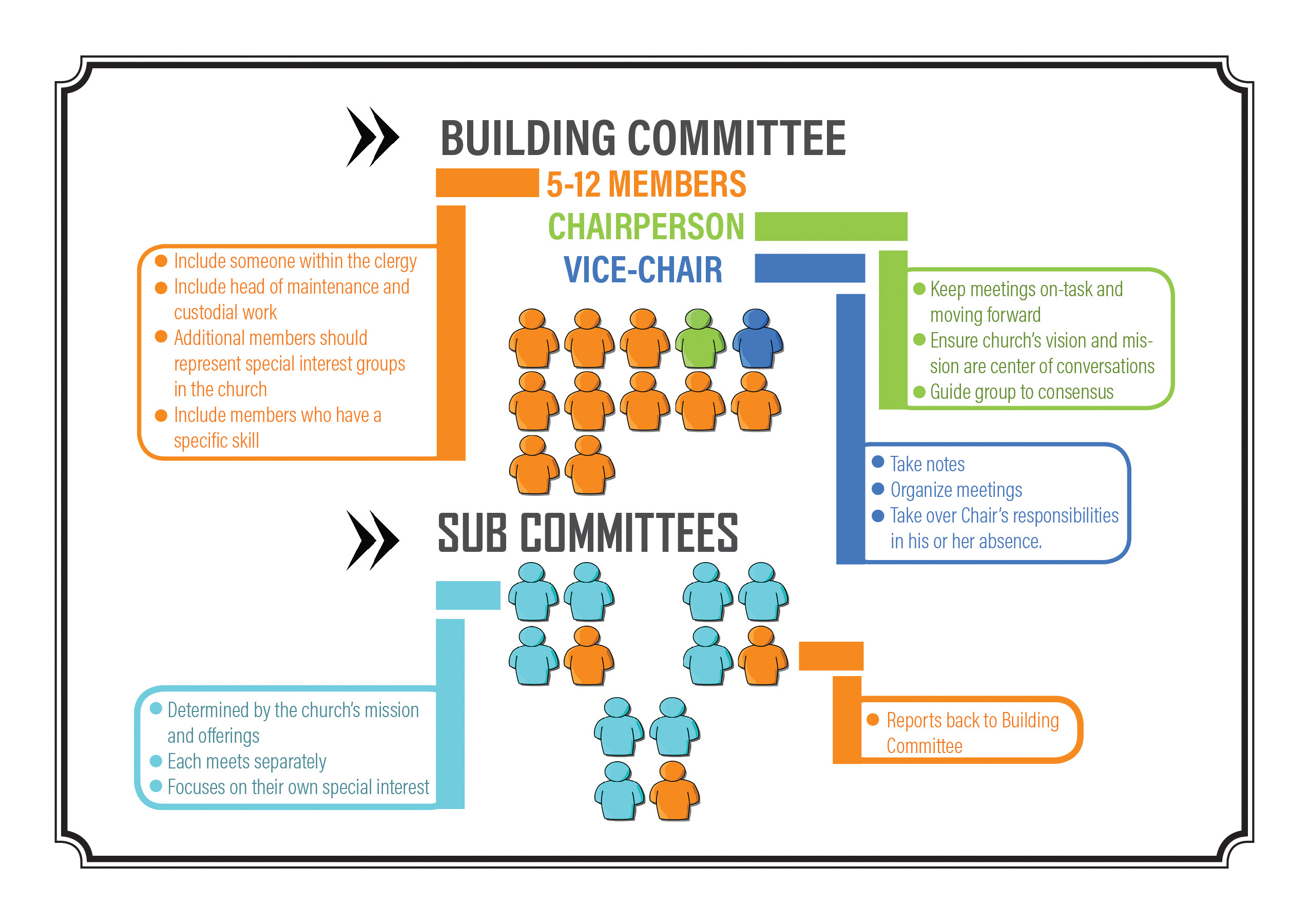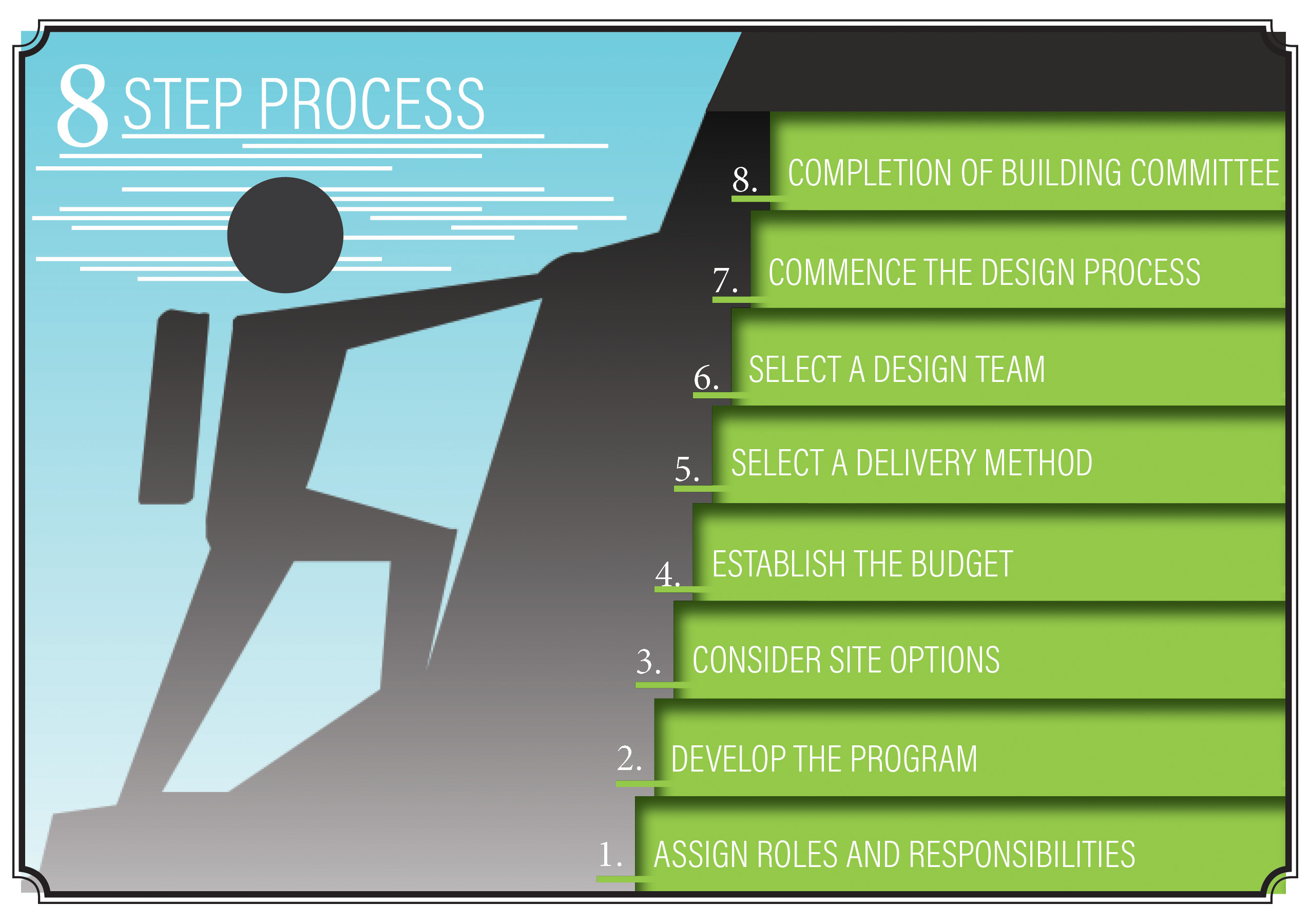
Forming a Church Building Committee
April 10, 2019
Is your congregation pondering the idea of adding on, remodeling, renovating, building a new facility or simply reviewing your long-term facility needs?
If the answer is yes, we’d like to offer some assistance to help you get started.
RSArchitects has worked with numerous congregations to expand, reconfigure, or relocate their facilities, in order to accommodate the congregation with the space required for continued spiritual growth.
Over the years, we’ve seen several practices that consistently result in a positive planning and implementation experience. We’ve broken down our insight into two categories: forming the Building Committee and sub-committees, and taking action through an 8-Step Process.
Although there are no exact requirements for Building Committees, we believe our suggestions will make the process more efficient and, in the long run, beneficial to your entire congregation.
BUILDING COMMITTEE GOAL:
To represent the entire congregation in facilitating the design and construction of the approved project, which reflects the needs of the Church and is within the stated budget.
Each committee will vary as to its involvement and authority. We’ve worked with some that report directly to the congregation and others that report to and get approval from the church council.
COMPOSITION:

We recommend that the Building Committee consists of 5 to 12 members. 1 member should be the chairperson and 1 member, the vice-chair. The chairperson will be responsible for keeping the meetings on-task and progressing forward, as well as ensuring that the church’s mission and vision are at the forefront of conversations. This person should be someone that can help bring all the members to a consensus when it comes time to make decisions.
The vice-chair of the committee should take notes and otherwise help organize the meetings. This person would also take over the chair’s responsibilities in his/her absence.
An essential member of the committee is someone within the church’s clergy. This is usually the person that leads the formation of the Building Committee, however, some religious leaders do not take this charge. If that is the case in your church, be sure to still include a clergy person on the committee — they need to be represented in the decision-making.
It is also very good practice to include the person that heads up the maintenance/custodial work for the church. This person will have great insight into the electrical, plumbing, and HVAC conditions and needs.
Additional members of the committee should represent the special interests of the church. If your church includes any of the following programs, one person from each of these programs should be on the committee: education, daycare, fellowship, youth group, community outreach, music, etc.
Lastly, you may wish to include church members who have a specific skill. For instance, a person that works in finances, as a banker or accountant, would be a beneficial addition to the committee. Likewise, a person who works in production would be an asset for planning the lighting, sound, and video for the sanctuary.
In our experience, it has been quite successful to have each member of the Building Committee oversee a specialty sub-committee. This approach expands participation to more church members, and streamlines the entire process.
Each sub-committee meets on their own and focuses on their particular special interest. The Building Committee liaison is then responsible for bringing the information back to the full Building Committee for review and consideration.
Sub-committees are determined by the church’s mission and offerings, so they vary widely from one church to another. Some sub-committees that we’ve seen include: Finance, Sanctuary, Music, Fellowship, Education, Office, Future Needs, Exterior, Design, and Relocation.
8 STEP PROCESS:

1. Assign Roles and Responsibilities. Roles and responsibilities are assigned at the time of assembling the Building Committee. Be sure each member has a clear understanding of what their role and responsibilities will be when asking them to be on the Committee.
2. Develop the Program. It’s important for the Building Committee to discuss and develop a preliminary program of needs. This means determining the spaces needed, as well as the capacity for each space. Do you need a worship space that seats 500? Do you need 8 classrooms that can hold 15 people, plus 2 that can hold 40 each? Do you need a kitchen? Do you want an outdoor worship space? These are examples of questions your Building Committee will consider during this step.
3. Consider Site Options (for new construction and additions). The Building Committee will need to determine if the church’s mission can be met at its current location by adding onto the existing campus, or if it is time to relocate to a new, larger site in order to expand and fulfill its mission. Things to consider when selecting a site are soil conditions and drainage. We recommend engaging a soils engineer to test the soils for bearing capacity and to put together a site survey drawing, showing the topography of the site, along with above and below grade elements and utilities.
4. Establish the Budget. Establish an overall preliminary budget that is an achievable goal for your congregation. Remember that your project is going to incur fees not included in the construction costs. Items not included, or normally not included, in the construction estimate would be: legal fees; fund raising costs; relocation or moving costs; moveable furnishings; professional fees for soil borings, site survey, and architectural/engineering design; and fees for extension of utilities/streets assessed by the City.
5. Select a Delivery Method. There are three common methods to facilitate the design and construction of a project: Design-Build, Design-Bid-Build, and Construction Manager. Read up on these methods in our previous post before choosing the one that best fits your needs.
6. Select a Design Team. Once the delivery method for designing and building the church is selected, the committee needs to proceed with the selection of the design and construction team members. The first selection will either be an architect, or an architect-contractor team. If an interview process is desired, a reasonable amount of time should be allocated for the candidates to present their credentials. Consider these important factors in your selection: firm and individual experience with religious projects; references; current workload of firm and individuals assigned to the project; proximity to the project site; and compatibility – the committee should feel comfortable with the design team.
7. Commence the Design Process. Now that the design team has been hired, the design process begins. The design team will work closely with the Building Committee to fully understand the church’s mission, and their needs. It is very important that the Building Committee be involved through the entire design and construction process. Just as the individuals on the design team remain consistent, keeping the members on the Building Committee consistent will ensure that progress continues in a forward motion – introducing new members often results in back-tracking and revisiting decisions that had already been made; this slows down progress.
8. Completion of Building Committee Task. Once the project is complete, the Building Committee’s task is also complete. At this point, some churches choose to disband the committee, some convert it to a property committee, and some keep it as a functioning group that regularly reviews the church’s long-term facility planning.
This information is presented from the architect’s perspective and our experience with committees. It is intended to provide an overview of the planning and building process common in a church setting. If you would like more information or a consultation by our firm, please contact our office at 605.336.6891.